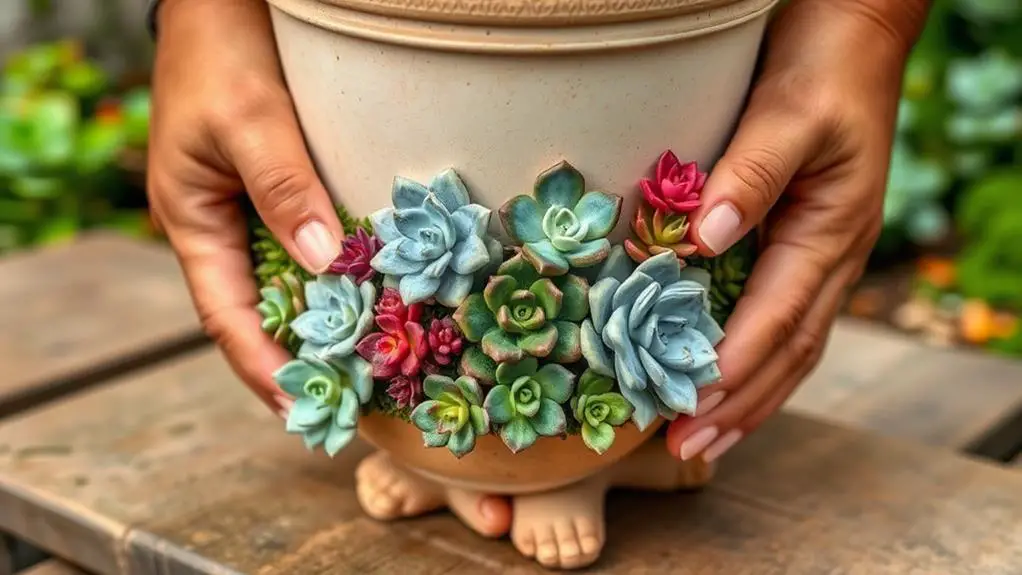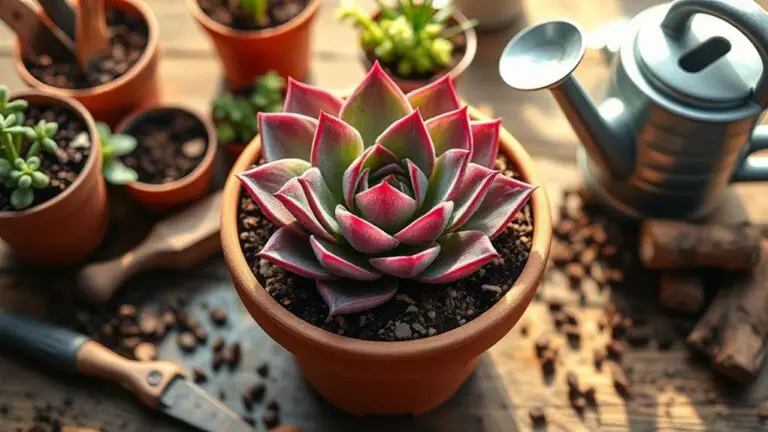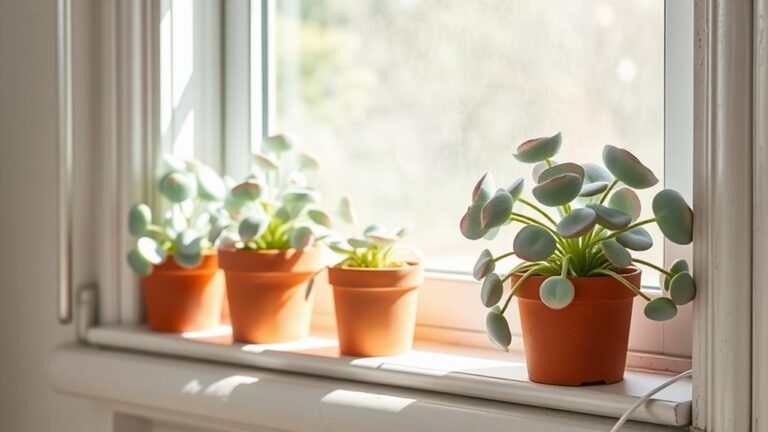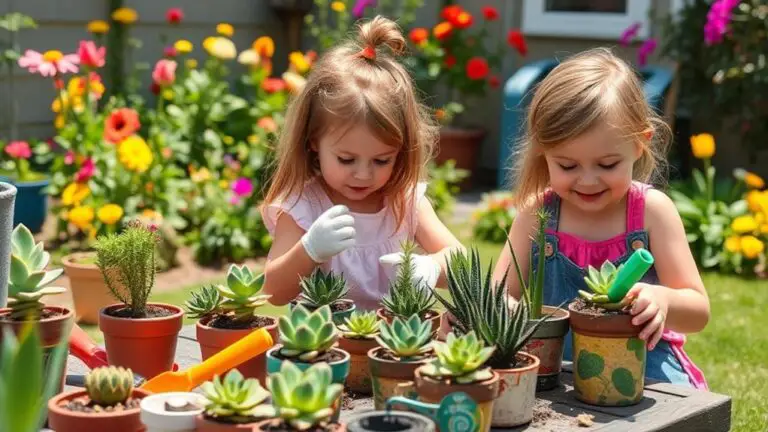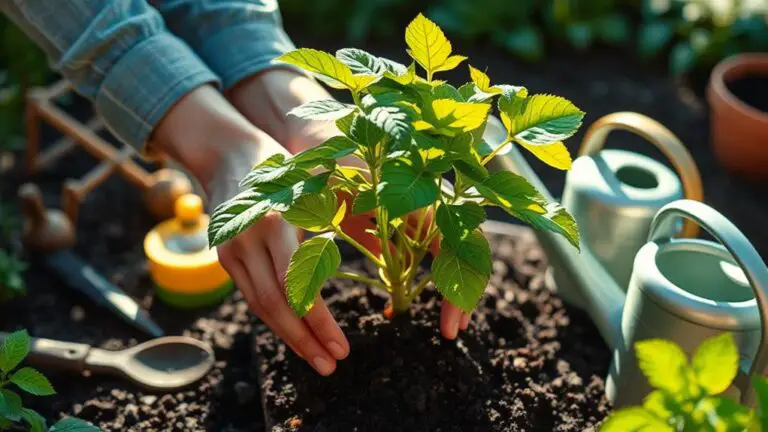How to Use Pot Feet for Succulent Container Gardens: A Step-by-Step Guide
If you're looking to enhance the health and aesthetics of your succulent container gardens, using pot feet can be a game-changer. Begin by selecting pot feet that match the style and size of your pots; this not only elevates the look but also improves airflow to the roots and prevents root rot. With the right pot feet, you'll facilitate better drainage, which is essential for succulents. But how do you go about choosing the perfect soil and arranging your succulents for maximum impact? Let's explore the next steps to achieve a thriving, visually appealing garden.
Select the Right Pot
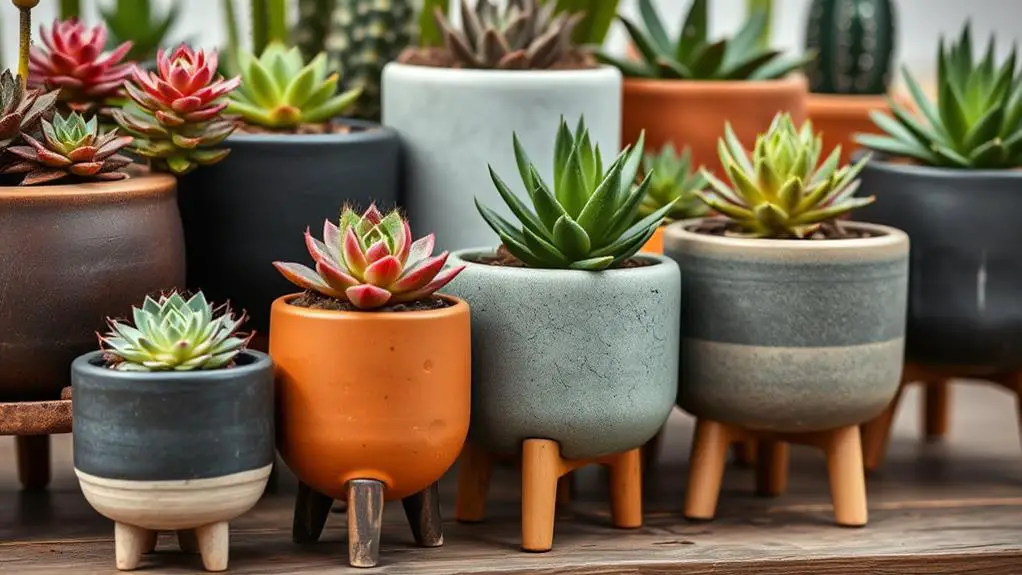
When selecting the right pot for your succulent garden, opt for a terracotta pot due to its aesthetic appeal and excellent drainage capability.
You'll want to guarantee it has a drainage hole to prevent water from accumulating, which can harm your succulents. Investing in a quality terracotta pot, around £20, not only adds a charming look to your garden but also supports healthy plant growth.
To enhance drainage, place broken pot pieces or gravel at the bottom before adding soil. This simple step helps keep excess water away from the roots.
Next, use a specialist tub and container compost. This kind of compost contains extra fertilizer and water-retaining granules, which are essential for the well-being of your succulent arrangement.
When planting, aim for the root balls to sit about an inch below the pot rim. This positioning makes watering easier and prevents water from pooling on the soil's surface.
Elevate With Pot Feet
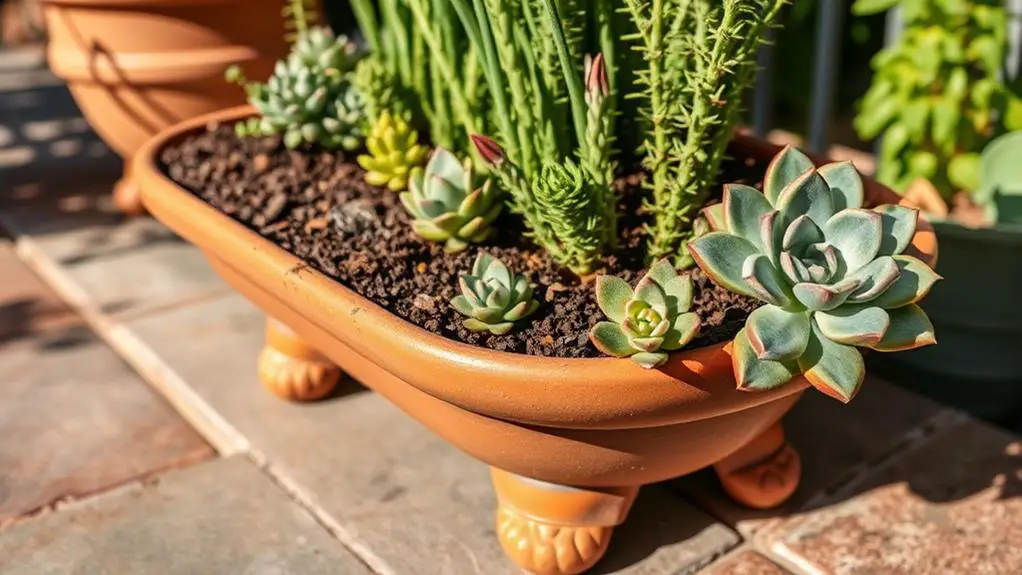
Now that you've selected the perfect pot and set up a solid foundation for your succulents, it's time to elevate your arrangement with pot feet.
Pot feet are essential for ensuring your plants stay healthy by enhancing airflow to the base of the pots. This increased airflow helps prevent water from accumulating, which can lead to root rot—a common problem for succulents.
By elevating your pots, pot feet allow excess water to drain freely. This is especially important for outdoor arrangements, where rain or overwatering can be a risk. Healthier root systems mean your succulents will thrive and look their best.
Using pot feet indoors can also protect your surfaces from water damage. Nobody wants unsightly water rings or stains on their furniture. With pot feet, you can keep your indoor spaces neat and tidy while still displaying your beautiful plants.
There are many styles and materials of pot feet to choose from, so you can find ones that match your decor and personal style. They can add a polished and professional finish to your succulent container garden, making your arrangement look even more stunning.
Choose the Perfect Soil
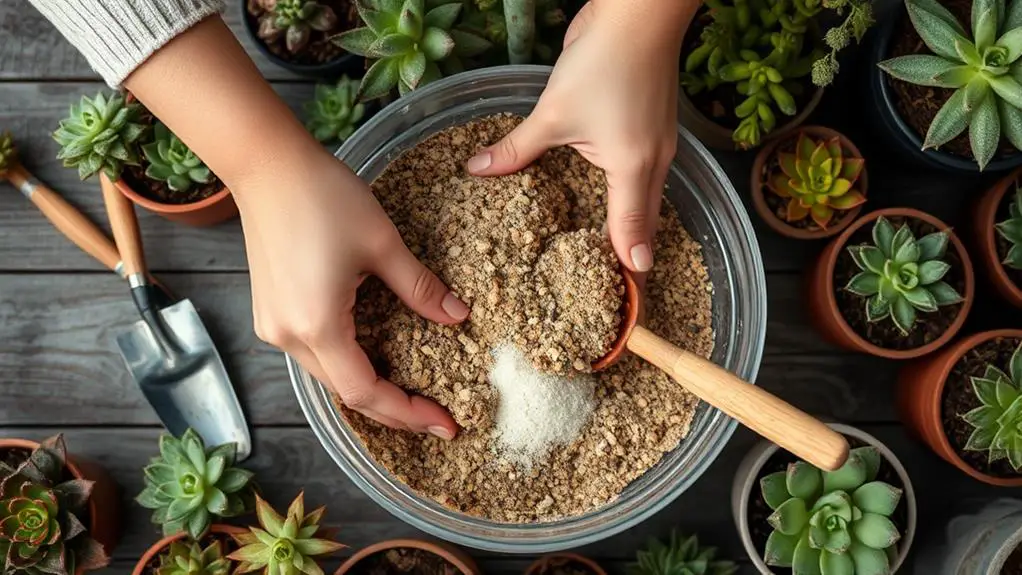
To guarantee your succulents thrive, choosing the perfect soil is vital. Start with specialist tub and container compost, which is designed for ideal succulent growth. This type of compost includes extra fertilizer and water-retaining granules that support healthy root systems.
Before planting succulents, make certain the compost is well-mixed and prepared. Aim to have the root balls sit about an inch below the pot rim. This positioning helps guarantee effective watering.
For excellent drainage, place broken pot pieces or gravel at the bottom of your terracotta pot. Good drainage prevents root rot, a common issue with succulents.
It's also important to select high-quality compost that allows dry pots to absorb water easily. This feature reduces the risk of drought stress on your plants.
Regularly checking the moisture levels in your soil is another key step. Adjust the compost as needed to maintain a suitable environment for your succulents.
Arrange Succulents Strategically

When arranging your succulents, think about placing the taller ones at the back, medium-sized plants in the middle, and trailing ones at the front.
Make sure to leave about half an inch to an inch between each plant so they've room to grow and your arrangement stays beautiful.
Adding hanging succulents like String of Pearls can also bring extra dimension and interest to the mix.
Above Pot Rim
Ensuring succulents are arranged so their tops sit above the pot rim is essential for both aesthetics and plant health. When you place your succulents, make sure the tops are slightly above the edge of the pot. This prevents water from pooling around the leaves, which can lead to rot.
It also improves airflow and drainage, keeping your plants healthy. Start by filling your pot partially with soil. Before finalizing the placement, check if the succulents sit correctly above the pot rim. Adjust the soil level as needed.
Using trailing varieties like Sedum burrito or Pachyveria glauca can add a beautiful cascading effect over the rim, enhancing visual appeal.
Consider the "thriller, filler, and spiller" concept for a dynamic arrangement. Place taller succulents at the back (the "thrillers"), medium-height ones in the middle (the "fillers"), and trailing varieties at the front (the "spillers"). This creates depth and interest.
Optimal Plant Spacing
Strategically spacing your succulents is essential for their growth and overall health. To achieve ideal plant spacing, place your succulents about 1/2" to 1" apart. This promotes healthy air circulation and guarantees each plant has room to grow.
Close planting can slow the growth of your succulents, which is great if you want to maintain the initial design of your arrangement for a longer time. However, keep in mind that tightly arranged plants might make watering more challenging. You'll need to be extra careful to guarantee each plant gets the water it needs without overwatering others.
On the other hand, spacing your succulents slightly apart will allow them to grow faster and fill in the gaps over time. This approach creates a fuller, more lush appearance. Think about how you want your arrangement to look in the future and plan accordingly.
When arranging your succulents, consider both the design and the growth preferences of each plant. By doing so, you'll create a beautiful, healthy succulent container garden that's easy to care for and will thrive over time.
Incorporate Visual Elements

To create an enchanting succulent garden, think about incorporating visual elements that add depth and intrigue.
Start by varying the height of your succulents. Using a taller plant like Kalanchoe tomentosa as a focal point can create a dynamic arrangement. Surround it with medium-height fillers and low-growing spillers to achieve a balanced look.
Consider adding trailing succulents like Sedum burrito or String of Pearls. These varieties spill over the edges of the pot, enhancing the garden's aesthetic appeal.
Playing with contrasting foliage colors and textures can also make your garden pop. For instance, pair the dark leaves of Lysimachia Midnight Sun with bright flowers for a striking visual effect.
A well-thought-out arrangement technique, such as the "thriller, filler, and spiller" concept, guarantees your container garden looks cohesive and balanced.
Finally, don't forget to use a professional top dressing. It not only enhances the overall look but also helps with moisture retention.
- Height variations add dynamic interest
- Trailing varieties enhance the aesthetic
- Contrasting colors and textures create visual impact
- Professional top dressing completes the look
Ensure Proper Watering

While creating a stunning succulent garden, it's vital to guarantee proper watering practices to maintain plant health. Using pot feet is a great way to achieve this. Elevating your succulent containers with pot feet allows for better airflow, which reduces the risk of water accumulation at the bottom. This is significant because too much water can lead to root rot, a common issue with succulents.
First, make sure your pots have drainage holes. These holes let excess moisture escape, preventing it from pooling at the bottom. When you water your succulents, check the moisture levels regularly. A little bit of attention goes a long way.
Elevated pots help maintain the right balance between moisture retention and drainage, making it easier for you to manage your watering schedule. Typically, succulents need watering every 1-3 weeks, depending on factors like the season and environmental conditions.
With pot feet, you can better control this timing, ensuring that your plants get just the right amount of water. Besides promoting healthier plants, pot feet also give your garden a professional look. By following these tips, you'll keep your succulent garden thriving and beautiful.
Maintain and Fertilize
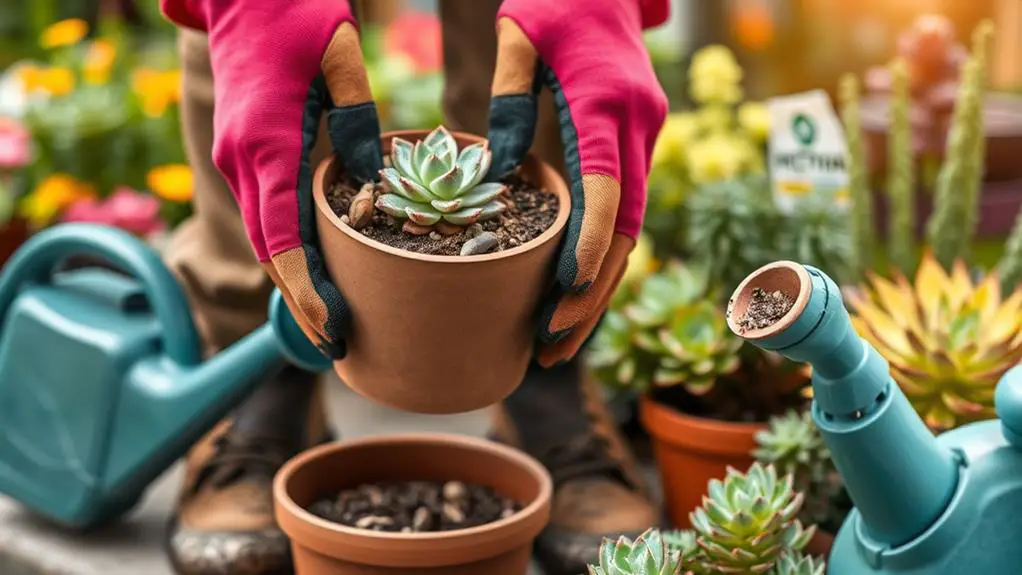
To keep your succulents healthy, regularly check the soil's moisture levels, making sure it's well-draining.
Use a liquid fertilizer weekly when you water, or try slow-release capsules that nourish your plants for up to six months.
Don't forget to deadhead flowers and clean up debris to keep your succulent garden looking its best.
Optimal Fertilization Techniques
Caring for your succulent garden involves more than just watering; it's crucial to get the fertilization right to keep your plants healthy and thriving. Ideal fertilization techniques guarantee that your shorter succulents grow strong and vibrant.
Start by using a liquid fertilizer weekly during watering. This provides continuous nutrient support, helping your succulents flourish.
Additionally, you can incorporate slow-release fertilizer capsules into the compost. Insert 5-6 capsules, and they'll release nutrients over a six-month period, offering a steady supply for your plants.
For a natural approach, consider organic options like pelletted chicken manure. Apply it monthly to nourish your succulents in a more eco-friendly way.
Keep an eye on your plants and adjust the fertilization frequency and amounts based on their specific needs and responses. This careful monitoring guarantees that your succulents receive just the right amount of nutrients.
- Weekly liquid fertilizer boosts growth
- Slow-release capsules offer long-term support
- Organic options like chicken manure are eco-friendly
- Monitoring and adjusting keep your plants thriving
Regular Maintenance Tips
Maintaining a healthy succulent garden goes beyond just occasional watering; regular upkeep is key to their thriving. Start by regularly checking the moisture levels in your succulent container garden. This helps prevent the pots from drying out and guarantees a healthy environment for your plants. Succulents need some water, but too much can be harmful.
For fertilization, consider using a liquid fertilizer weekly when you water your plants. This provides continuous nutrients to support new growth. Alternatively, you can use slow-release fertilizer capsules, which supply nutrients steadily over six months. If you prefer organic options, pelletted chicken manure can be applied monthly for natural nutrient support.
Deadheading spent flowers is another important task. Removing these helps promote blooming and enhances the visual appeal of your arrangement, keeping it fresh and vibrant.
Additionally, clean up debris around the pot regularly. This maintains a tidy appearance and prevents pests or diseases from affecting your succulents.
Always monitor plant growth and adjust your care routine as needed. By staying vigilant and proactive, you'll guarantee your succulent garden remains healthy and beautiful throughout the seasons.
Frequently Asked Questions
How Do You Make a Succulent Container Garden?
Start by choosing a terracotta pot with drainage holes. Fill it halfway with compost. Arrange taller succulents at the back, medium in the middle, and trailing ones in front. Water thoroughly, then add top dressing and pot feet.
How Do You Arrange a Succulent Planter?
Arrange your succulent planter by placing tall "thrillers" at the back, medium "fillers" in the middle, and trailing "spillers" at the front. Make certain plants are above the rim, with proper spacing, to prevent water pooling and encourage healthy growth.
How Do You Layer Succulent Pots?
Start by layering the bottom with drainage materials like gravel or broken pot pieces. Add high-quality potting mix, position succulents' root balls an inch below the rim, and follow the "thriller, filler, spiller" concept for a stunning arrangement.
How to Prepare a Succulent Garden Bed?
You should pick a well-draining pot with holes and fill it halfway with specialized compost. Position the succulent roots just below the rim, fill gaps with a dibber, and monitor moisture and compost needs regularly.
Conclusion
You've got this! Using pot feet for your succulent container gardens is easier than you think. Just follow these steps, and you'll guarantee your plants stay healthy and happy. Remember to choose the right pots, elevate them with feet, and check moisture levels regularly. Your succulents will thrive with proper care. Keep experimenting and enjoy the process. Happy gardening! You're well on your way to creating a beautiful garden space.

